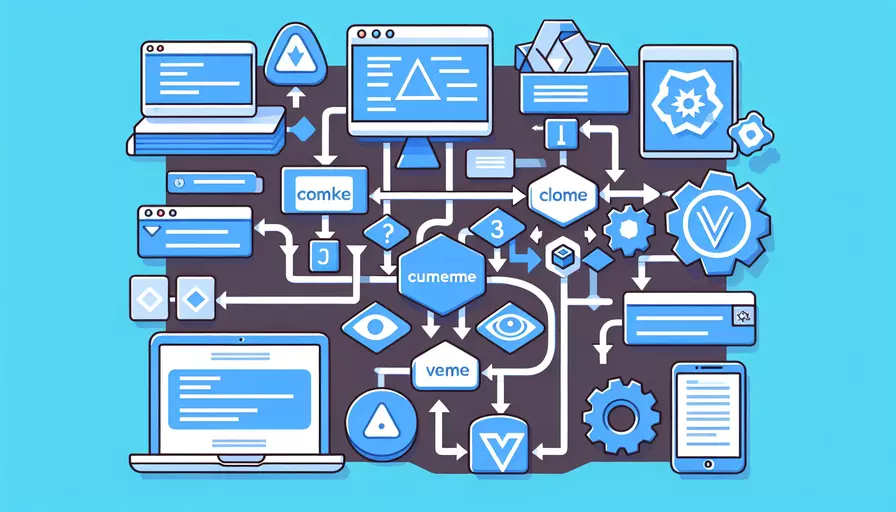
要理解Vue中的组件,1、组件是Vue应用的基本构建块;2、组件促进代码的重用和模块化;3、组件具有独立的逻辑和样式。组件在Vue中扮演着至关重要的角色,通过将应用程序分割成独立、可复用的小块,开发者能够更容易地管理和维护代码。在Vue中,组件可以是基础组件(如按钮、输入框)也可以是更复杂的结构(如整个表单或页面)。接下来,我们将详细探讨Vue组件的各个方面。
一、组件的定义和使用
在Vue中,组件可以用来封装可复用的代码和模板。定义一个组件通常需要以下步骤:
- 创建组件:使用
Vue.component全局注册组件,或者在单文件组件(.vue文件)中定义。 - 注册组件:在需要使用组件的Vue实例或其他组件中注册。
- 使用组件:在模板中通过自定义标签来引用和使用组件。
示例:
// 定义组件
Vue.component('my-component', {
template: '<div>A custom component!</div>'
});
// 创建Vue实例
new Vue({
el: '#app'
});
在HTML中:
<div id="app">
<my-component></my-component>
</div>
二、组件的基本结构
Vue组件的基本结构包括模板(template)、脚本(script)和样式(style)。在单文件组件中,这三个部分通常在一个.vue文件中:
<template>
<div class="my-component">
<!-- 模板内容 -->
</div>
</template>
<script>
export default {
data() {
return {
// 组件数据
};
},
methods: {
// 组件方法
}
};
</script>
<style scoped>
.my-component {
/* 组件样式 */
}
</style>
三、组件的生命周期
Vue组件具有一系列生命周期钩子函数,这些函数在组件实例的不同阶段自动调用。主要的生命周期钩子包括:
- beforeCreate:实例初始化之后,数据观测和事件机制未建立。
- created:实例创建完成,数据观测和事件机制已建立,但未挂载DOM。
- beforeMount:在挂载开始之前被调用。
- mounted:实例挂载到DOM后调用。
- beforeUpdate:数据更新时调用,发生在虚拟DOM重新渲染之前。
- updated:由于数据更改导致的虚拟DOM重新渲染和更新后调用。
- beforeDestroy:实例销毁之前调用。
- destroyed:实例销毁后调用。
这些生命周期钩子使得开发者可以在组件的不同阶段执行特定的代码,从而增强组件的功能和可维护性。
四、组件之间的通信
在Vue中,组件之间的通信主要通过以下几种方式实现:
-
父子组件通信:父组件通过
props向子组件传递数据,子组件通过事件向父组件发送消息。props:用于父组件向子组件传递数据。$emit:子组件通过事件将消息发送给父组件。
示例:
// 父组件<template>
<div>
<child-component :message="parentMessage" @childEvent="handleChildEvent"></child-component>
</div>
</template>
<script>
import ChildComponent from './ChildComponent.vue';
export default {
data() {
return {
parentMessage: 'Hello from parent!'
};
},
methods: {
handleChildEvent(payload) {
console.log('Received event from child:', payload);
}
},
components: {
ChildComponent
}
};
</script>
// 子组件
<template>
<div>
<p>{{ message }}</p>
<button @click="sendEvent">Send Event to Parent</button>
</div>
</template>
<script>
export default {
props: ['message'],
methods: {
sendEvent() {
this.$emit('childEvent', 'Hello from child!');
}
}
};
</script>
-
兄弟组件通信:通过一个中央事件总线(Event Bus)或使用Vuex进行状态管理。
- 中央事件总线:创建一个新的Vue实例,将其作为事件总线,在兄弟组件之间传递事件。
- Vuex:集中式状态管理库,适用于复杂的应用。
示例:
// 创建事件总线const EventBus = new Vue();
// 组件A
<template>
<div>
<button @click="sendEvent">Send Event</button>
</div>
</template>
<script>
export default {
methods: {
sendEvent() {
EventBus.$emit('customEvent', 'Hello from Component A');
}
}
};
</script>
// 组件B
<template>
<div>
<p>{{ message }}</p>
</div>
</template>
<script>
export default {
data() {
return {
message: ''
};
},
created() {
EventBus.$on('customEvent', (payload) => {
this.message = payload;
});
}
};
</script>
-
全局状态管理:对于大型应用,推荐使用Vuex进行全局状态管理。Vuex提供了一套完整的状态管理方案,能够帮助开发者更好地管理应用中的状态。
五、动态组件和异步组件
-
动态组件:通过
<component>标签和is属性,可以动态地渲染不同的组件。示例:
<template><div>
<button @click="currentComponent = 'componentA'">Show Component A</button>
<button @click="currentComponent = 'componentB'">Show Component B</button>
<component :is="currentComponent"></component>
</div>
</template>
<script>
import ComponentA from './ComponentA.vue';
import ComponentB from './ComponentB.vue';
export default {
data() {
return {
currentComponent: 'componentA'
};
},
components: {
componentA: ComponentA,
componentB: ComponentB
}
};
</script>
-
异步组件:在需要时才加载组件,适用于减少初始加载时间的大型应用。
示例:
// 定义异步组件const AsyncComponent = () => ({
component: import('./AsyncComponent.vue'),
loading: LoadingComponent,
error: ErrorComponent,
delay: 200,
timeout: 3000
});
// 使用异步组件
<template>
<div>
<async-component></async-component>
</div>
</template>
<script>
export default {
components: {
AsyncComponent
}
};
</script>
六、组件的高级特性
-
插槽(Slots):插槽允许父组件向子组件传递模板内容。Vue提供了三种类型的插槽:默认插槽、具名插槽和作用域插槽。
示例:
// 父组件<template>
<child-component>
<template v-slot:default>
<p>This is a default slot content.</p>
</template>
<template v-slot:named>
<p>This is a named slot content.</p>
</template>
<template v-slot:scoped="slotProps">
<p>{{ slotProps.text }}</p>
</template>
</child-component>
</template>
// 子组件
<template>
<div>
<slot></slot>
<slot name="named"></slot>
<slot name="scoped" :text="scopedText"></slot>
</div>
</template>
<script>
export default {
data() {
return {
scopedText: 'This is scoped slot text.'
};
}
};
</script>
-
自定义指令:在组件中可以创建自定义指令,来扩展模板语言。
示例:
// 定义自定义指令Vue.directive('focus', {
inserted: function (el) {
el.focus();
}
});
// 使用自定义指令
<template>
<input v-focus>
</template>
-
混入(Mixins):混入提供了一种分发可复用功能的非常灵活的方式。一个混入对象可以包含任意组件选项,当组件使用混入对象时,所有的混入对象的选项将被“混合”进入该组件本身的选项。
示例:
// 定义混入const myMixin = {
created() {
this.hello();
},
methods: {
hello() {
console.log('Hello from mixin!');
}
}
};
// 使用混入
export default {
mixins: [myMixin],
created() {
console.log('Hello from component!');
}
};
总结起来,Vue组件是构建现代Web应用的基础,通过理解和掌握组件的定义、使用、生命周期、通信、动态加载和高级特性,开发者可以创建高效、可维护且可复用的代码结构。为了进一步提高开发效率,建议深入研究Vue的文档和社区资源,了解更多最佳实践和案例。
相关问答FAQs:
1. 什么是Vue组件?
Vue组件是Vue.js框架中的一个重要概念,用于将页面拆分成独立的、可复用的模块。组件由模板、脚本和样式组成,可以包含自己的数据和逻辑。通过组件化的方式,可以更好地组织代码,提高代码复用性和维护性。
2. 如何定义和使用Vue组件?
在Vue中,可以通过Vue.component方法来定义全局组件,也可以通过components选项来定义局部组件。定义组件时,需要指定组件的名称、模板、方法等。
定义全局组件示例:
Vue.component('my-component', {
template: '<div>This is my component.</div>',
methods: {
// 组件的方法
}
});
定义局部组件示例:
new Vue({
components: {
'my-component': {
template: '<div>This is my component.</div>',
methods: {
// 组件的方法
}
}
}
});
使用组件时,可以在模板中直接引用组件的名称,并传递数据或属性。
<my-component></my-component>
3. Vue组件的生命周期是什么?
Vue组件有多个生命周期钩子函数,用于在组件不同阶段执行特定的操作。常用的生命周期钩子函数有created、mounted、updated和destroyed。
- created:在组件实例被创建之后调用,可以在这个钩子函数中进行数据初始化、事件监听等操作。
- mounted:在组件被挂载到DOM之后调用,可以在这个钩子函数中进行DOM操作、数据请求等操作。
- updated:在组件的数据发生变化时调用,可以在这个钩子函数中对DOM进行更新操作。
- destroyed:在组件被销毁之前调用,可以在这个钩子函数中进行清理工作,如取消事件监听、清除定时器等。
生命周期钩子函数可以用于在不同阶段执行相应的操作,例如在created钩子函数中进行数据初始化,在mounted钩子函数中进行DOM操作。这样可以更好地控制组件的行为和状态。
文章标题:vue如何理解组件,发布者:飞飞,转载请注明出处:https://worktile.com/kb/p/3618941

 微信扫一扫
微信扫一扫  支付宝扫一扫
支付宝扫一扫 